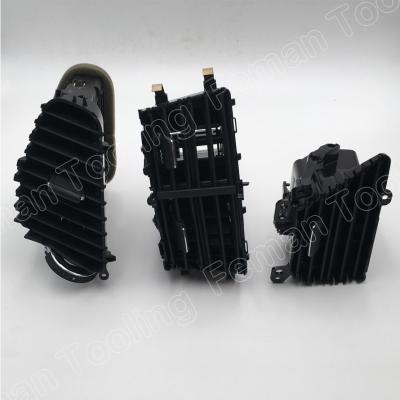Ⅰ. Mold opening direction and parting line of injection mold design
At the beginning of the design of each injection product, the mold opening direction and parting line should be determined first to ensure that the core-pulling slider mechanism is minimized and the influence of the parting line on the appearance is eliminated.
1. After the mold opening direction is determined, the reinforcing ribs, buckles, protrusions and other structures of the product are designed to be consistent with the mold opening direction as much as possible, so as to avoid core pulling and reduce seam lines and prolong the life of the mold.
2. After the mold opening direction is determined, an appropriate parting line can be selected to avoid undercuts in the mold opening direction, so as to improve the appearance and performance.
Ⅱ. The demoulding slope of the injection mold design
1. Appropriate demoulding slope can avoid product pulling (pulling). The demoulding slope of the smooth surface should be greater than or equal to 0.5 degrees, the surface of the fine skin (sand surface) should be greater than 1 degree, and the surface of the coarse skin should be greater than 1.5 degrees.
2. Appropriate demoulding slope can avoid product top damage, such as top white, top deformation, and top rupture.
3. When designing a product with a deep cavity structure, the slope of the outer surface should be larger than the slope of the inner surface as much as possible to ensure that the mold core is not offset during injection molding, obtain a uniform product wall thickness, and ensure the material strength of the product opening.
Ⅲ. Product wall thickness of injection mold design
1. All molding plastic types have a certain range of wall thickness, generally 0.5~4mm. When the wall thickness exceeds 4mm, it will cause the cooling time to be too long and cause shrinkage and other problems. Consider changing the product structure.
2. Uneven wall thickness will cause surface shrinkage.
3. Uneven wall thickness will cause pores and weld lines.
Ⅳ. Reinforcing ribs for injection mold design
1. Reasonable application of reinforcing ribs can increase product rigidity and reduce deformation.
2. The thickness of the reinforcing ribs must be ≤ (0.5~0.7) T product wall thickness, otherwise the surface will shrink.
3. The single-sided slope of the reinforcing rib should be greater than 1.5° to avoid top injury.
Ⅴ. Fillet of injection mold design
1. Too small rounded corners may cause stress concentration in the product such as insert molding electronics, resulting in product cracking.
2. Too small fillet may cause stress concentration in the mold cavity, resulting in cavity cracking.
3. Setting a reasonable rounded corner can also improve the processing technology of the mold. For example, the cavity can be directly milled with an R cutter to avoid low-efficiency electrical machining.
4. Different rounded corners may cause the movement of the parting line, and different rounded corners or inclinations should be selected according to the actual situation.
Ⅵ. The injection mold design hole
1. The shape of the hole should be as simple as possible, generally round.
2. The axial direction of the hole is the same as that of the mold opening, which can avoid core pulling.
3. When the aspect ratio of the hole is greater than 2, the drafting slope should be set. At this time, the diameter of the hole should be calculated according to the minor diameter size (maximum solid size).
4. The length-diameter ratio of blind holes is generally not more than 4. Anti-hole pin punching and bending.
5. The distance between the hole and the edge of the product is generally greater than the aperture size.

.jpg)